
Mobile is a city and the county seat of Mobile County, Alabama, United States. The population within the city limits was 187,041 at the 2020 census, down from 195,111 at the 2010 census. After a successful vote to annex areas west of the city limits in July 2023, Mobile's population increased to 204,689 residents. It is now the second-most-populous city in Alabama, after Huntsville.
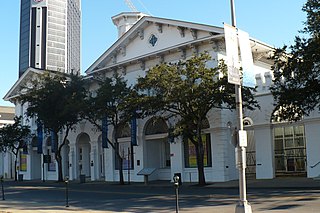
Old City Hall, also known as the Southern Market, is a historic complex of adjoining buildings in Mobile, Alabama, that currently houses the History Museum of Mobile. The complex was built from 1855 to 1857 to serve as a city hall and as a marketplace. It was declared a National Historic Landmark in 1973, as a rare well-preserved example of a 19th-century multifunction civic and commercial building.

Creole architecture in the United States is present in buildings in Louisiana and elsewhere in the South, and also in the U.S. associated territories of Puerto Rico and the U.S. Virgin Islands. One interesting variant is Ponce Creole style.

The Bettie Hunter House is a historic African American residence in Mobile, Alabama, United States. It was the residence of Bettie Hunter, a former enslaved African who grew wealthy from a successful hack and carriage business she operated in Mobile with her brother, Henry. The fall of New Orleans during the American Civil War had made Mobile the South's only major port on the Gulf of Mexico. Transportation of goods to and from the port depended on the city's teamsters and their horse or mule-drawn wagons. Bettie Hunter was part of a group of African Americans who recognized the opportunities in the carriage business and she cornered this part of the transportation market in Mobile.
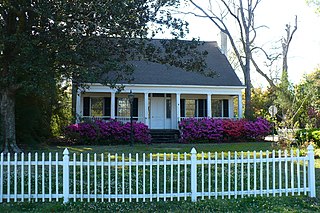
The Carlen House, also known as the Carlen House Museum, is a historic house museum in Mobile, Alabama, United States. The house was built in the Gulf Coast cottage style in 1843. It was the residence of Michael and Mary Carlen, Irish immigrants, and their twelve children. Operated as a farm during the 19th century, the Mobile County School Board acquired 38 acres (15 ha) of the property from the Carlen family in 1923 as the site for a new public city school. As a result, the house is now on the northern edge of the Murphy High School campus. It was placed on the National Register of Historic Places on June 12, 1981.

This is a list of the National Register of Historic Places listings in Cleveland, Ohio.

The South Lafayette Street Creole Cottages is a grouping of three historic Creole cottages on South Lafayette Street in Mobile, Alabama, United States. They were built in 1852. All three were placed as a group on the National Register of Historic Places on November 7, 1976.

The Denby House is a historic raised cottage in Mobile, Alabama. The one-story brick house was built by Charles Denby in 1873. It was added to the National Register of Historic Places on January 5, 1984. In addition to being listed individually on the National Register of Historic Places, it is also a contributing building to the Lower Dauphin Street Historic District.

This is a list of the National Register of Historic Places listings in Mobile, Alabama.
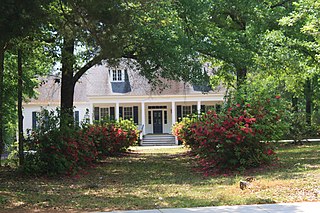
The Collins–Marston House is a historic house located at 4703 Old Shell Road in Mobile, Alabama.

The Miller–O'Donnell House was a historic residence in Mobile, Alabama. The two-story house was built in 1837 in the Gulf Coast Cottage style. It featured a masonry brick ground floor with a wood-frame main floor above. It was placed on the National Register of Historic Places on February 19, 1982, but has since been destroyed.
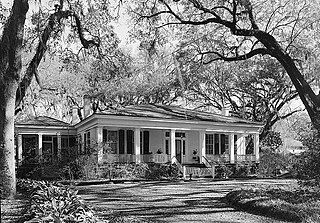
Georgia Cottage, also known as the Augusta Evans Wilson House, is a historic residence in Mobile, Alabama, United States. It was added to the National Register of Historic Places on September 14, 1972, based on its association with Augusta Jane Evans. She was one of the most popular American novelists of the nineteenth century and the first female author in the United States to earn over $100,000 for her work, but has been largely forgotten in recent times.

The Hawthorn House was a historic house in Mobile, Alabama, United States. The 1+1⁄2-story wood-frame structure, on a brick foundation, was built in 1853 in the Gulf Coast Cottage style by Joshua K. Hawthorn. It was placed on the National Register of Historic Places on May 21, 1984, based on its architectural significance. The house was demolished in October 2021.

The Pfau–Crichton Cottage, best known as Chinaberry, is a historic cottage in Mobile, Alabama. The 1+1⁄2-story, wood-frame, Gulf Coast cottage was completed in 1862. The house was built by the Pfau family, but its best known resident was Miss Anne Randolph Crichton, known for the elaborate gardens that she developed on the property. She enlisted in the Navy at the outbreak of World War I and continued her service until retirement, in the 1950s. She traveled extensively in Europe during the 1930s, maintaining scrapbooks that recorded her visits to various art museums, gardens, and monuments. She was the last direct descendant of Hugh Randolph Crichton, the founder of the Mobile County town of Crichton. The house was added to the National Register of Historic Places on October 18, 1984, as a part of the 19th Century Spring Hill Neighborhood Thematic Resource listing of well-preserved buildings that represent the historical development of what was once the village of Spring Hill.
The Hiram B. Austin House is a historic residence on Mon Louis Island in Mobile County, Alabama, United States. Situated on the western shore of Mobile Bay, the 1+1⁄2-story wood-frame structure was built in 1837 in the Gulf Coast Cottage style. It was placed on the National Register of Historic Places on February 11, 1988.

The Magee Farm, also known as the Jacob Magee House, is a historic residence in Kushla, Alabama, United States. Built by Jacob Magee in 1848, the 1+1⁄2-story wood-frame structure is an example of the Gulf Coast Cottage style. The house is best known as the site of preliminary arrangements for the surrender of the last Confederate States Army east of the Mississippi River. Confederate General Richard Taylor negotiated a ceasefire with Union General Edward Canby at the house on April 29, 1865. Taylor's forces, comprising 47,000 Confederate troops serving in Alabama, Mississippi and Louisiana, were the last remaining Confederate force east of the Mississippi River. The Magee Farm was placed on the National Register of Historic Places on February 11, 1988. In 2004, partially through the efforts of the Civil War Trust, a division of the American Battlefield Trust, which helped save 12.6 acres of the farm, the house was opened as a museum. It ceased operation as a museum in 2010, due to a lack of public support and declining revenues, and was listed for sale. It was then listed on the Alabama Historical Commission's Places in Peril listing for 2010.

The Paul C. Murphy House is a 2.5-story residence in southeast Portland, in the U.S. state of Oregon. Built in 1916 in the English Cottage style, it was added to the National Register of Historic Places in 1991.

Aduston Hall is a historic antebellum plantation house in the riverside town of Gainesville, Alabama. Although the raised cottage displays the strict symmetry and precise detailing of the Greek Revival style, it is very unusual in its massing. The house is low and spread out over one-story with a fluid floor-plan more reminiscent of a 20th-century California ranch house than the typically boxy neoclassical houses of its own era.

Henry William Cleaveland was an American architect based in New York, New York, and then San Francisco, California, and Portland, Oregon. He was one of the founding members of the American Institute of Architects, and several of his works have been listed on the National Register of Historic Places. His works include Ralston Hall, a National Historic Landmark in the San Francisco Bay Area, the original Palace Hotel in San Francisco, and the Bidwell Mansion in Chico, California.
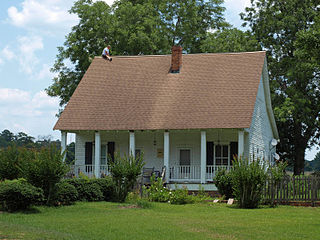
The Nelson House, also known as the Reynolds House, is a historic house located in Latham, Alabama. It is listed on the National Register of Historic Places. Its 1988 NRHP nomination asserted it is locally significant as the "purest example" of the Creole Cottage style of architecture in Baldwin County.

























